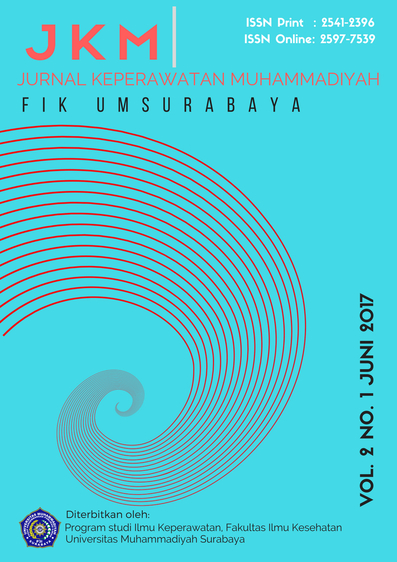Evidence Based Nursing Self-Management Untuk Mengurangi Konstipasi Pada Pasien Kanker Payudara Yang Menjalani Kemoterapi
DOI:
https://doi.org/10.30651/jkm.v2i1.1090Abstract
Â
Self-management  (SM) adalah salah satu penerapan Evidence Based Nursing (EBN) untuk mengurangi konstipasi pada pasien kanker payudara akibat kemoterapi yang mendapatkan antiemetik 5-hydroxytryptamine (serotonin; 5HT3 yaitu ondansentron). SM terdiri dari abdominal massage, abdominal streching, dan pendidikan posisi buang air besar yang tepat. Tujuan dari EBN ini adalah mengidentifikasi efektivitas self-management (SM) terhadap penurunan konstipasi pada pasien kanker payudara. Skor konstipasi diukur menggunakan constipation assessment scale (CAS). Dalam penerapan EBN ini didapatkan bahwa SM dapat mengurangi konstipasi ditandai dengan penurunan skor CAS. SM dapat digunakan sebagai salah satu terapi non farmakologi untuk mengurangi konstipasi, bersifat mudah dilakukan, aman dan secara teknis praktis untuk mengurangi konstipasi pada pasien kanker payudara karena tidak dibutuhkan keterampilan atau pelatihan khusus untuk melakukannya.
References
American Cancer Society. (2011). Breast Cancer, p.2-4,61. Philadelphia.
American Cancer Society (2014). Breast Cancer Facts & Figures.
American Nurses Association, 2004. handle with care. ANA American Nurses Association.
Braun MB, SimonsonSJ. Introduction to Massage Therapy. Baltimore: Lippincott, Williams and Wilkins; 2005.
Desen, Wan. (2011). Patologi Tumor. Dalam: Japaries, W, ed. Buku Ajar Onkologi Klinis ed 2. Jakarta: Balai Penerbit FK UI.
Hanai A, Ishiguro H, Sozu T, Tsuda M, Arai H, Mitani A, et al. (2016). Effect of a self-management program on antiemetic-induced constipation during chemotherapy among breast cancer patients: a randomised controlled clinical trial. Breast Cancer Research and Treatment 155:99-107.
International Agency for Research on Cancer (IARC). (2012). Monographs on the Evaluation of Carcinogenic Risks to Humans; Vol. 100D. A Review of Human Carcinogens. Part D: Radiation/IARC Working Group on the Evaluation of Carcinogenic Risks to HumansWHO, Lyon, France
Kemenkes RI. (2014). Profil Kesehatan Indonesia Tahun 2013. Jakarta: Kemenkes RI.
Kemenkes RI. (2015). Profil Kesehatan Indonesia Tahun 2014. Jakarta: Kemenkes RI.
Koch T, Hudson S. Older people and laxative use: literature review and pilot study report. J Clin Nurs 2000; 9: 516-525
Lamas K, Lindholm L, Stenlund H et al. (2009). Effects of abdominal massage in management of constipation–A randomized controlled trial. Int J Nurs Stud 46:759–767.
LeMone, P, Burke, Karen. (2008). Medical Surgical Nursing, Critical Thinking in Client Care (4th Edition). New Jersey: Prentice Hall Health.
Lindley A (2014) Abdominal Massage as Part of the Management of Chronic Constipation. www.nht.nhs.uk/ documentHandler.cfm?dld=2250 &pflag=docm93jijm4n2250 (Last accessed: June 25 2014.
Liu Z. Mechanism of Abdominal Massage for Difficult Defecation in a Patient with Myelopathy. J Neurol. 2005;252(10): 1280-82.
McClurg D, Lowe-Strong A. Does Abdominal Massage Relieve Constipation?. Nursing Times. 2011; 107(12): 20-2.
McKay, Sherry L, MSN, ARNP,G.N.P., F.A.A.N.P., Fravel, Michelle,PharmD., B.C.P.S., & Scanlon, Cathy, MS,R.D., L.D. (2012). Management of constipation. Journal of Gerontological Nursing, 38(7), 9-15. doi:http://dx.doi.org/10.3928/00989134-20120608-01.
Penedo FJ, Dahn JR (2005) Exercise and well-being: a review of mental and physical health beneï¬ts associated with physical activity. Curr Opin Psychiatry 18:189–193
Rhee SH, Pothoulakis C, Mayer EA (2009) Principles and clinical implications of the brain-gut-enteric microbiota axis. Nat Rev Gastroenterol Hepatol 6:306–314
Sinclair M. The Use of Abdominal Massage to Treat Chronic Constipation. J Bodyw Mov Ther. 2011; 15(4): 436-45.
Smeltzer & Bare. (2008). Textbook of Medical Surgical Nursing Vol.2. Philadelphia: Linppincott William & Wilkins
Downloads
Published
Issue
Section
License
- Penulis tetap memegang hak atas karyanya dan memberikan hak publikasi pertama kepada jurnal ini yang secara simultan karya tersebut dilisensikan di bawah:Â Creative Commons Attribution-ShareAlike 4.0 International (CC BY-SA 4.0)













